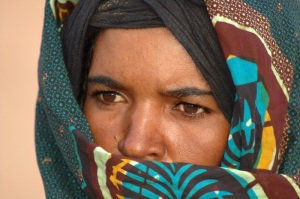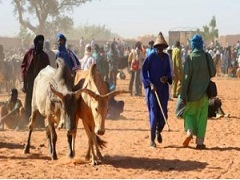You are using an out of date browser. It may not display this or other websites correctly.
You should upgrade or use an alternative browser.
You should upgrade or use an alternative browser.
3,100 yr old remains from Tanzania resemble modern Cushites/Horners
- Thread starter Apollo
- Start date
- Status
- Not open for further replies.
Are somalis and oromo related to fulanis?
Yes, probably, but it's complicated and not universal. It's a big group, spread over a lot of territory, and substantially admixed. The Fulani (Fulbe, Peul) in the Sudan are 34.6% E1b1b. (https://en.wikipedia.org/wiki/Y-DNA_haplogroups_in_populations_of_Sub-Saharan_Africa) The Wodaabe are another subgroup, probably more ethnically pure than other subgroups.. The language and most of the MtDNA are West African. Also a lot of R.
This paper is lengthy and substantial, getting into a number of hypotheses:
https://tariganter.wordpress.com/2011/09/17/who-are-the-fulani-people-their-origins/
.

"The early origin of Fulani People is most fascinating and deepened in mystery with widely divergent opinions. Many scholars believe that they are of Judaeo-Syrian origin. However, it is generally recognized that Fulani descended from nomads from both North Africa and from sub-Sahara Africa. They came from the Middle-East and North Africa and settled into Central and West Africa from the Senegal region they created the Tekruur Empire which was contemporary to the Ghana Empire. Then, they spread in all the countries in West-Africa, continuing to lead their nomadic life style. They created here and there mixed states where they sometimes were the dominant group. But more often, they were absorbed by the indigenous population whom they had dominated.
While some have speculated over the origin of Fulani people, current linguistic and genetic evidence suggests an indigenous West African origin among the Peul. The vast majority of genetic lineages associated with them reflect those most commonly seen in other West Africans. Their language is also of West African origin, most closely related to that of the Wolof and Serer ethnic groups. Historical and archaeological records indicate that Peul-speakers have resided in western Africa since at least the 5th century A.D. as well. Interestingly, rock paintings in the Tassili-n-Ajjer suggests the presence of proto-Fulani cultural traits in the region by at least the fourth millennium B.C. Scholars specializing in Fulani culture believe that some of the imagery depicts rituals that are still practiced by contemporary Fulani people."

.
There are a few Cushitic tribes here, fascinating.
yuusufdiin
child of afgooye
Cushites were like pastoralist ''Bantus'' (if you get what I mean), less successful population-wise, but similar recent expansion.
Bantu origin = South East Nigeria/South West Cameroon
Cushite origin = between Blue Nile-Upper Egypt-Red Sea

So you believe the origins of somalis and other Cushitics was somewhere at the top blue circle?
Last edited:
It would make sense given that the Beja , the most northerly Cushitic speakers , are still in the vicinity of that area ( Eastern Sudan, Eritrea , small areas of deep Southern Egypt ). Their language is the most divergent of the Cushitic branch , that is , from Eastern Cushitic and Southern . The groups that became Somali , Oromo , etc. probably branched out from the early Cushitic communities in Northern Sudan into Ethiopia , Somalia and so forth . Some Cushitic fellows went as far as Rwanda and south towards Tanzania, hence why you have groups like Iraqw of Tanzania and the Tutsi of Rwanda , who show signs of Cushitic ancestry .
So you believe the origins of somalis and other Cushitics was somewhere at the top blue circle?

# Suugo theory .
XoosBoos
Hiraab Commander
Hmm interesting. Never head of Blemmyes, would check in that.
The Beja were the Blemmyes, who were not included in classical Kush, which was toward the center of the Sudan and included sections of both the Blue and White Niles.
Apollo
VIP

The Beja were the Blemmyes, who were not included in classical Kush, which was toward the center of the Sudan and included sections of both the Blue and White Niles.
Cushitic is just a label. It has nothing to do with the 'Kush' kingdom, get over that fact. It revers to the ethno-linguistic group of the Horn.
Semitic is also just a label and also has nothing to do with biblical fairy tales of Shem.
Cut the semantics game.
Apollo
VIP

So you believe the origins of somalis and other Cushitics was somewhere at the top blue circle?
Nope. Closer to being from Eritrea than that blue area. Somalis entered via the coastline of the Red Sea rather than via Ethiopia.
Nope. Closer to being from Eritrea than that blue area. Somalis entered via the coastline of the Red Sea rather than via Ethiopia.
The second "T" migration maybe. E-V-32 gets added in the area of Kush and then follows up the Nile. The Iraqw, for instance, do not go through Somalia.
Apollo
VIP
The second "T" migration maybe. E-V-32 gets added in the area of Kush and then follows up the Nile. The Iraqw, for instance, do not go through Somalia.
Wrong.
Both entered around the same time, zero evidence for a second migration.
Wrong.
Both entered around the same time, zero evidence for a second migration.
First "T" migration at 23 kya enters the central Sahara and is included in all of E1b1b. . Second migration at 6-8 kya to 3 kya (likely from a Neolithic migration into the Red Sea Hills) forms the "T" clans in the north. E1b1b-V32 (52% of all Somalis) comes up the Nile and enters Somalia from the south and west.
Here is the second "T" migration:
https://www.eupedia.com/europe/Haplogroup_T_Y-DNA.shtml
"The higher frequency of T in East Africa would be due to a founder effect among Neolithic farmers or pastoralists from the Middle East. One theory is that haplogroup T spread alongside J1 as herder-hunters in the Pre-Pottery Neolithic period, leaving the Zagros mountains between 9,000 and 10,000 BCE, reaching the Egypt and the southern Arabian peninsula around 7,000 BCE, then propagating from there to the Horn of Africa, and later on to Madagascar. However, considering that J1 peaks in Yemen and Sudan, while T1 is most common in southern Egypt, Eritrea and Somalia, the two may not necessarily have spread together. They might instead have spread as separate nomadic tribes of herders who colonised the Red Sea region during the Neolithic, a period than spanned over several millennia. Nevertheless both are found in all the Arabian peninsula, all the way from Egypt to Somalia, and in Madagascar. This contrasts with other Near Eastern haplogroups like G2a and J2, which are conspicuously absent from East Africa, and rare in the Arabian peninsula. Nowadays, T1a subclades dating from the Neolithic found in East Africa include Y16247 (downstream of CTS2214) and Y16897. Other subclades dating from the Bronze Age (see below) are present as well, such as Y15711 and Y21004, both downstream of CTS2214."
James Dahl
VIP
Noone has really pinned down where T comes from exactly. or what historical tribe it's even associated with, it's quite mysterious.
We need to form a coalition of indigenous Africans that includes Cushites, Khoisans, Nilotes, Pgymies, etc. All of these communities face aggression from the bantu expanders. It's time we work together.there is this whole youtube channel by somali bantus dedicated to claiming somali land, history etc,. they're a ticking time bomb, ask yourself what happened to countless other groups, khosians, pygmies etc,. Bantu are doing the greatest expansion in human history.
yeah we should form a militia and reconquer our landsWe need to form a coalition of indigenous Africans that includes Cushites, Khoisans, Nilotes, Pgymies, etc. All of these communities face aggression from the bantu expanders. It's time we work together.
- Status
- Not open for further replies.
Trending
-
Iranian MMA fighter gets attacked for kicking a female promoter just for showing her bum!
- Started by K-M-O
- Replies: 36
-
Syrian man’s family is against him marrying a Somali woman. Is it racism?
- Started by Laiis
- Replies: 403
-
